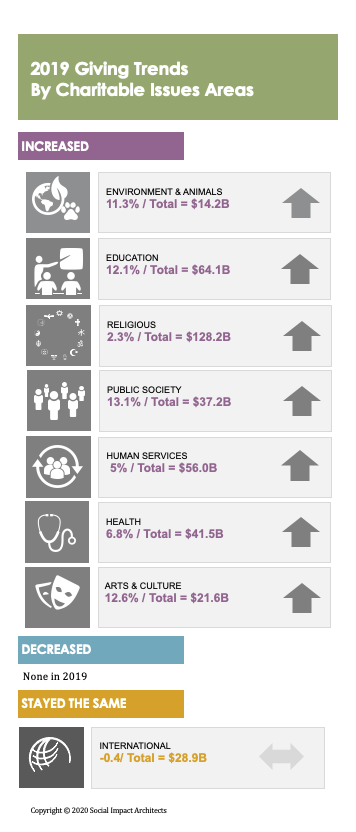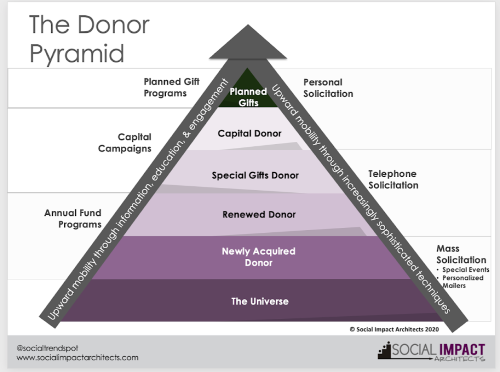 Americans are very generous – in fact, more Americans give to charity than vote. In the first six months of 2020, despite more than half of the U.S. workforce experiencing unemployment or reduced income due to COVID-19, Americans have stepped up to support important charitable work. Recent research suggests that most donors plan to increase (25%) or maintain (54%) their giving levels from 2019.
Americans are very generous – in fact, more Americans give to charity than vote. In the first six months of 2020, despite more than half of the U.S. workforce experiencing unemployment or reduced income due to COVID-19, Americans have stepped up to support important charitable work. Recent research suggests that most donors plan to increase (25%) or maintain (54%) their giving levels from 2019.
Each year since 1956, the sector anxiously awaits the results of the Giving USA Report. This annual report looks at the past year and releases key data and trends. But, at its midpoint, 2020 has already seen noticeable shifts. What, if anything, can be gleaned from 2019 data that can be relevant for today’s seismic shifts? It turns out that this year’s Giving USA report was a very interesting read and has a lot of good findings to help with our work today. In addition, The Giving Institute and the Giving USA Foundation also recently launched The Generosity Commission, which is studying “what drives people to be generous” and the changing nature of giving trends. From these sources and our observations, we will share our normal annual update as well as some thoughts and ideas on today’s giving trends and what the future may hold.
Now for the good news – Americans gave roughly $450 billion to U.S. charities in 2019, which was almost a 4.2% increase (or 2.8% adjusted for inflation) from giving in 2018. Even with the economy softening in late 2019, giving was still strong. Almost all issue areas did well – the chart below summarizes the changes in 2019. However, based on historical trends during recessions, we expect these numbers will likely shift downward or stay the same in 2020, with the possibility that human services charities and public society might grow slightly.
We also saw healthy giving by foundations, with an increase of 2.5% – totaling almost 17% of all giving. Corporations also gave more (13.4%) in 2019 – likely due to corporate tax cuts, a robust economy and growth in many sectors. We expect foundation giving to remain strong in 2020 as local and national foundations make giant leaps to ensure that the social sector stays solvent. We also hope that donor-advised funds will be active in giving to basic needs and other grassroots work. Because of COVID-19 and its impact on most corporations’ bottom lines, we expect corporate giving to dip in 2020.
We were also encouraged by a surge of individual giving in 2019 (up 4.7% compared to a decline in 2018). Individual giving still makes up the vast majority of giving in the US – with almost 70% of total giving coming from individual gifts. We hope the number and size of individual gifts will be maintained in 2020, especially with the universal charitable tax credit included in the CARES Act and new research that shows millennials plan to give at record-breaking levels to support COVID-19 relief and social justice initiatives.
Ideas for 2020
2020 has been an anomaly in many ways, so giving will likely also be difficult to predict. As a result, it is even more important for your development department to track donation and messaging success rates, focus on the stewardship of every donor and work creatively since normal fundraising tactics have had to shift this year. Here are some thoughts for consideration:
Idea #1: Monitor donors regularly and pivot as needed
Whether through a database or another tool, monitor donor trends over time and adjust as needed. Practice hyper-stewardship to keep donors connected to your cause. If you don’t have a working donor and messaging database, now is the time to get one that helps you with analytics and customization of messaging. Make the most of your database by meeting regularly to review the data and pivot as needed based on the results of your collective work.
Idea #2: Think “Retention, retention, retention”
The easiest donor to get is the one you already have. Disturbingly, only 20% of first-time donors are retained. To prevent this, develop a donor pyramid that starts with your first engagement with donors and helps them become regular donors through experiences with your nonprofit (e.g., volunteering). This is harder to do during COVID-19, but think creatively and connect to your donors’ interests and talents. Then, once they are regular donors, start working with them to increase their gifts. Gather board members and your advisory council members together for a “calling/note-writing/Zoom party” to thank donors, ask for increased gifts and encourage lapsed donors to re-engage.
Idea #3: Elevate messaging through relevancy to 2020 issues
Double-check your story. Is it resonating as it once did? We have always believed that nonprofits should stay within their mission, but also lead with messages around their unique value proposition and find ways to stand out from the crowd. However, what was considered unique and valuable in 2019 has changed in 2020, so your messaging has to shift with the times. We have written many blogs over the past months covering these topics, so we encourage you to really dig deep and rethink your value proposition and key messaging moving forward. Donors want to feel closely connected to your cause and want to see tangible examples of your mission at work. Don’t tell them, but show them that you are stepping up and staying relevant in these turbulent times. Feel free to also refresh your storytelling skills this summer with our new e-learning course on Storytelling.
Idea #4: Engage in more than checkbook philanthropy
Many trends have converged to prove that with every generation we are redefining what generosity means – it no longer just means checkbook philanthropy. The tried and true giving mix – time, talent, treasure – even has a new “T”: testimonials. Use this shift in 2020 to rethink all your old fundraising ways. For example, when it comes to making personal connections with donors, tailoring your messages based on generational preferences can have a positive impact. Millennials won’t give unless they have a deep connection to the cause or the person asking, so wait to ask until they have a direct connection. Gen Xers want to see tangible examples of work and prefer campaign-based giving (e.g., donating to stock the food pantry of a local school). Gen Zers, who are known to be socially conscious, crave unique experiences, so consider investing in innovative, influencer-driven digital strategies. Take some time to rethink how you are customizing your messages by audience so that your messages have the best chance of making an impression.
For a deeper dive into the Giving USA data, Nonprofit Quarterly has an excellent webinar – visit their site for the recording and slides. We welcome any additional analysis on giving trends as well as any ways your organization is shifting its fundraising efforts.


